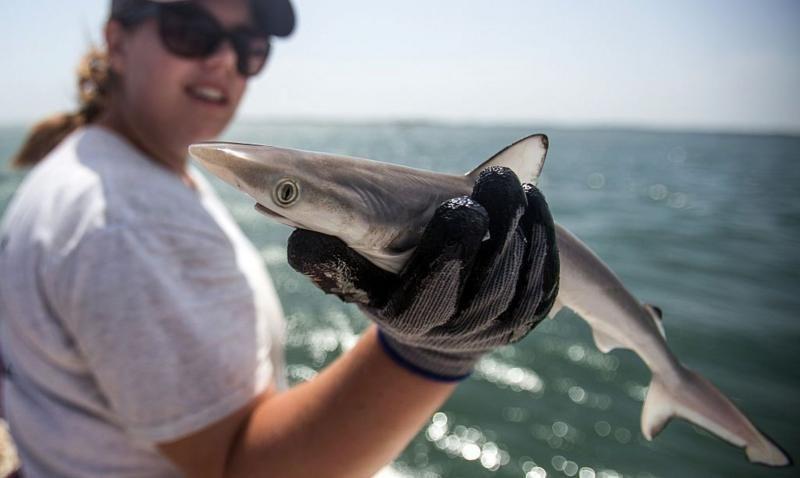Sharks off the coast of Rio de Janeiro have tested positive for cocaine, according to researchers from the Oswaldo Cruz Foundation.
Marine biologists examined 13 Brazilian dogfish (also known as sharks) off the coast of Rio and detected high levels of cocaine in their muscles and liver.
This is the first study to detect cocaine in sharks, and the concentration is approximately 100 times higher than that found in other marine animals.
There are several hypotheses that attempt to explain how the drug reached the animals’ bodies.
Some experts believe that cocaine reaches the water through illegal laboratories used to manufacture the drug or through the feces of some users.
Packages of cocaine lost or thrown into the sea by traffickers could also be one of the sources of the drug, but investigators consider this hypothesis less likely.
“Our work postulates that both hypotheses may be the cause of the cocaine detected: chronic exposure due to human consumption of cocaine in Rio de Janeiro (use, metabolization and discharge through human urine and feces by wastewater outfalls), as well as illegal laboratories,” explains one of the authors of the study, Rachel Davis, a biologist and researcher at the Laboratory for Evaluation and Promotion of Environmental Health at the Oswaldo Cruz Institute (IOC/Fiocruz).
“We don’t usually see many bales of cocaine thrown or lost at sea here, unlike what is reported in Mexico and Florida. That’s why we prefer the two hypotheses mentioned above.”

There is also a theory that the drug is spread through sea water when divers try to supply ships so they can take cocaine to other countries.
Sara Novais, a marine ecotoxicologist at the Centre for Environmental and Marine Sciences at the Polytechnic University of Leiria in Portugal, told the journal Science that the discovery is “very important and potentially worrying.”
All of the females in the study were pregnant, but it is not known what effect cocaine exposure has on the fetuses.
More research is also needed to determine whether the drug is altering the sharks’ behavior.
Previous research indicates that the drugs likely have similar effects in animals and humans.
Scientists only tested one species of shark, but believe other species in the region may also test positive for cocaine.
“Since sharks are carnivores and the primary route of exposure to many chemical contaminants is through food, it is highly likely that the animals our sharks eat (crustaceans, other fish) are contaminated,” said Rachel Davis.
Brazil is a cocaine flow route
The presence of cocaine in Brazil is significant because the country is geographically attractive for sending the drug to other consumer markets, mainly Europe and Africa, explains Camila Nunes Dias, a doctor in sociology from the University of São Paulo (USP) and professor at the Federal University of ABC (UFABC).
As Nunes explains, this has turned the country into a strategic hub for the criminal factions that organize this transport.
“The geographical issue is central due to Brazil’s border to the west with the drug-producing countries – Peru, Colombia and Bolivia – and the exit to the Atlantic through several ports. I think this explains why a good part of this product that goes to Europe and Africa passes through Brazil.”
“The country has a continental dimension and is positioned in a very strategic way.”
Camila Nunes believes that, contrary to what the authors of the investigation say, the water was not contaminated by cocaine refined in laboratories in the region, but by divers during the transfer of the drug to the ships.
“We have identified many strategies for transporting cocaine to ships using divers. My assessment, seen from afar, is that this explanation makes much more sense,” says the specialist, who is also part of NEV, the USP Center for Studies on Violence.

The researcher points out that cocaine reaches Brazil via rivers and roads before being sent to Europe through various ports and airports in the country.
He explains that cocaine shipped to the United States is controlled primarily by Mexican and Colombian traffickers. But Brazil is an important shipping hub for Europe and Africa.
“All Brazilian ports are gateways. The use of each of these ports is controlled by various criminal groups, such as the PCC (First Capital Command) and the Comando Vermelho (Red Command).”
It can affect the human body
Researcher Rachel Davis says the drug may end up entering the human body through the common consumption of sharks as food in Brazil.
“Cocaine has already entered the food chain, as humans routinely consume sharks in Brazil and many other countries, including the United States, the United Kingdom and Mexico, and they are often sold generically as flakes, fish and chips, dogfish and other names,” Davis says.
But it is not clear whether the amount of drugs ingested by eating these animals could be harmful to health.
“We cannot yet have concerns about human health along the food chain, as no limits have been set regarding negative health effects. As far as human health is concerned through other means, including direct exposure to water, we believe that this would be minimal,” says the researcher.
Keep reading:
* Does Coca-Cola contain cocaine? Curious facts you didn’t know about the drink
* Soy nuggets filled with cocaine discovered
* VIDEO: Narco recipe! avocados stuffed… with cocaine

Click here to read more stories from BBC News Mundo.
You can also follow us on Youtube, Instagram, TikTok, X, Facebook and in the new WhatsApp channelwhere you’ll find breaking news and our best content.
And remember that you can receive notifications in our app. Download the latest version and activate them..
- Nitazenes, the “superopioids” more potent than heroin and fentanyl that are spreading across Europe and America
- Why is there an oversupply of coca leaf and cocaine in Latin America (and what repercussions is this having in the region and the world)
